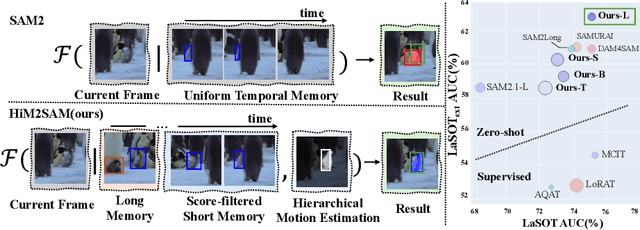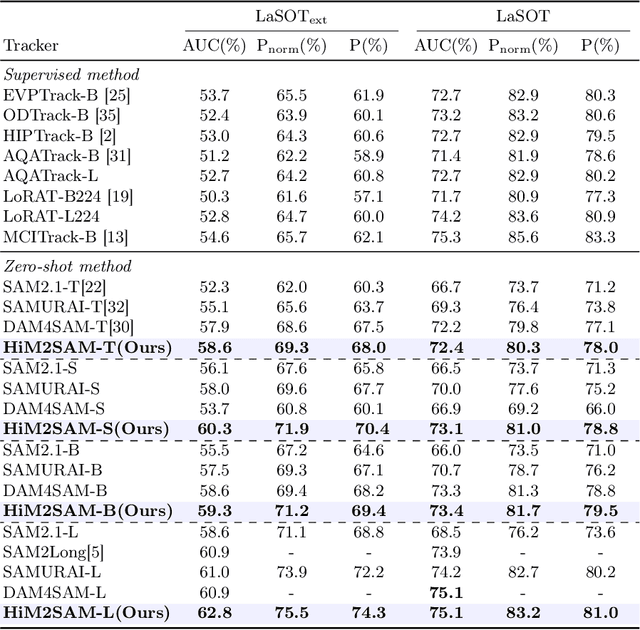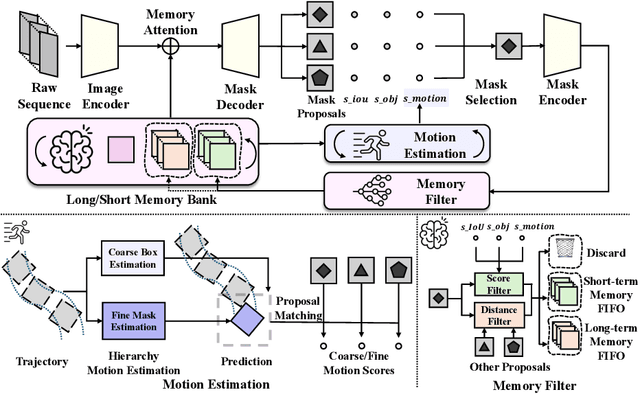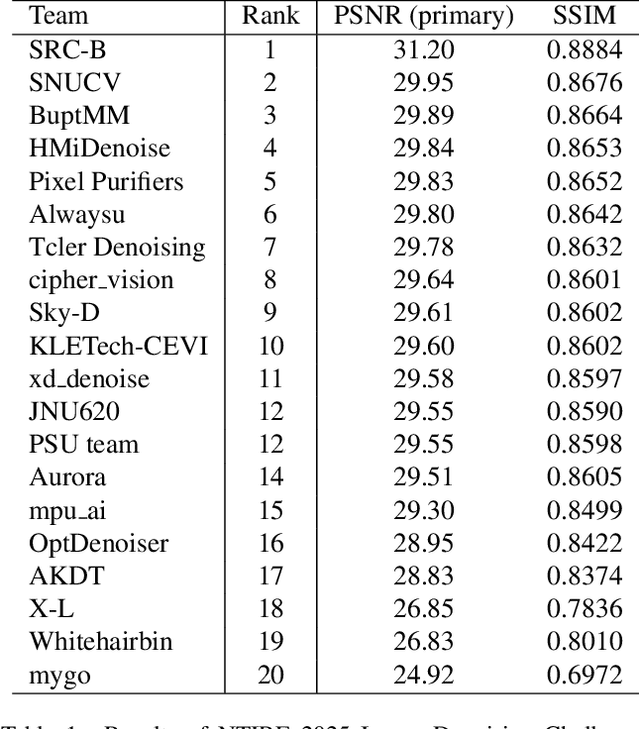Yawei Li
HiM2SAM: Enhancing SAM2 with Hierarchical Motion Estimation and Memory Optimization towards Long-term Tracking
Jul 10, 2025



Abstract:This paper presents enhancements to the SAM2 framework for video object tracking task, addressing challenges such as occlusions, background clutter, and target reappearance. We introduce a hierarchical motion estimation strategy, combining lightweight linear prediction with selective non-linear refinement to improve tracking accuracy without requiring additional training. In addition, we optimize the memory bank by distinguishing long-term and short-term memory frames, enabling more reliable tracking under long-term occlusions and appearance changes. Experimental results show consistent improvements across different model scales. Our method achieves state-of-the-art performance on LaSOT and LaSOText with the large model, achieving 9.6% and 7.2% relative improvements in AUC over the original SAM2, and demonstrates even larger relative gains on smaller models, highlighting the effectiveness of our trainless, low-overhead improvements for boosting long-term tracking performance. The code is available at https://github.com/LouisFinner/HiM2SAM.
PhysioWave: A Multi-Scale Wavelet-Transformer for Physiological Signal Representation
Jun 12, 2025Abstract:Physiological signals are often corrupted by motion artifacts, baseline drift, and other low-SNR disturbances, which pose significant challenges for analysis. Additionally, these signals exhibit strong non-stationarity, with sharp peaks and abrupt changes that evolve continuously, making them difficult to represent using traditional time-domain or filtering methods. To address these issues, a novel wavelet-based approach for physiological signal analysis is presented, aiming to capture multi-scale time-frequency features in various physiological signals. Leveraging this technique, two large-scale pretrained models specific to EMG and ECG are introduced for the first time, achieving superior performance and setting new baselines in downstream tasks. Additionally, a unified multi-modal framework is constructed by integrating pretrained EEG model, where each modality is guided through its dedicated branch and fused via learnable weighted fusion. This design effectively addresses challenges such as low signal-to-noise ratio, high inter-subject variability, and device mismatch, outperforming existing methods on multi-modal tasks. The proposed wavelet-based architecture lays a solid foundation for analysis of diverse physiological signals, while the multi-modal design points to next-generation physiological signal processing with potential impact on wearable health monitoring, clinical diagnostics, and broader biomedical applications.
WaveFormer: A Lightweight Transformer Model for sEMG-based Gesture Recognition
Jun 12, 2025Abstract:Human-machine interaction, particularly in prosthetic and robotic control, has seen progress with gesture recognition via surface electromyographic (sEMG) signals.However, classifying similar gestures that produce nearly identical muscle signals remains a challenge, often reducing classification accuracy. Traditional deep learning models for sEMG gesture recognition are large and computationally expensive, limiting their deployment on resource-constrained embedded systems. In this work, we propose WaveFormer, a lightweight transformer-based architecture tailored for sEMG gesture recognition. Our model integrates time-domain and frequency-domain features through a novel learnable wavelet transform, enhancing feature extraction. In particular, the WaveletConv module, a multi-level wavelet decomposition layer with depthwise separable convolution, ensures both efficiency and compactness. With just 3.1 million parameters, WaveFormer achieves 95% classification accuracy on the EPN612 dataset, outperforming larger models. Furthermore, when profiled on a laptop equipped with an Intel CPU, INT8 quantization achieves real-time deployment with a 6.75 ms inference latency.
Manifold-aware Representation Learning for Degradation-agnostic Image Restoration
May 24, 2025Abstract:Image Restoration (IR) aims to recover high quality images from degraded inputs affected by various corruptions such as noise, blur, haze, rain, and low light conditions. Despite recent advances, most existing approaches treat IR as a direct mapping problem, relying on shared representations across degradation types without modeling their structural diversity. In this work, we present MIRAGE, a unified and lightweight framework for all in one IR that explicitly decomposes the input feature space into three semantically aligned parallel branches, each processed by a specialized module attention for global context, convolution for local textures, and MLP for channel-wise statistics. This modular decomposition significantly improves generalization and efficiency across diverse degradations. Furthermore, we introduce a cross layer contrastive learning scheme that aligns shallow and latent features to enhance the discriminability of shared representations. To better capture the underlying geometry of feature representations, we perform contrastive learning in a Symmetric Positive Definite (SPD) manifold space rather than the conventional Euclidean space. Extensive experiments show that MIRAGE not only achieves new state of the art performance across a variety of degradation types but also offers a scalable solution for challenging all-in-one IR scenarios. Our code and models will be publicly available at https://amazingren.github.io/MIRAGE/.
MiniMax-Speech: Intrinsic Zero-Shot Text-to-Speech with a Learnable Speaker Encoder
May 12, 2025Abstract:We introduce MiniMax-Speech, an autoregressive Transformer-based Text-to-Speech (TTS) model that generates high-quality speech. A key innovation is our learnable speaker encoder, which extracts timbre features from a reference audio without requiring its transcription. This enables MiniMax-Speech to produce highly expressive speech with timbre consistent with the reference in a zero-shot manner, while also supporting one-shot voice cloning with exceptionally high similarity to the reference voice. In addition, the overall quality of the synthesized audio is enhanced through the proposed Flow-VAE. Our model supports 32 languages and demonstrates excellent performance across multiple objective and subjective evaluations metrics. Notably, it achieves state-of-the-art (SOTA) results on objective voice cloning metrics (Word Error Rate and Speaker Similarity) and has secured the top position on the public TTS Arena leaderboard. Another key strength of MiniMax-Speech, granted by the robust and disentangled representations from the speaker encoder, is its extensibility without modifying the base model, enabling various applications such as: arbitrary voice emotion control via LoRA; text to voice (T2V) by synthesizing timbre features directly from text description; and professional voice cloning (PVC) by fine-tuning timbre features with additional data. We encourage readers to visit https://minimax-ai.github.io/tts_tech_report for more examples.
Any Image Restoration via Efficient Spatial-Frequency Degradation Adaptation
Apr 19, 2025Abstract:Restoring any degraded image efficiently via just one model has become increasingly significant and impactful, especially with the proliferation of mobile devices. Traditional solutions typically involve training dedicated models per degradation, resulting in inefficiency and redundancy. More recent approaches either introduce additional modules to learn visual prompts, significantly increasing model size, or incorporate cross-modal transfer from large language models trained on vast datasets, adding complexity to the system architecture. In contrast, our approach, termed AnyIR, takes a unified path that leverages inherent similarity across various degradations to enable both efficient and comprehensive restoration through a joint embedding mechanism, without scaling up the model or relying on large language models.Specifically, we examine the sub-latent space of each input, identifying key components and reweighting them first in a gated manner. To fuse the intrinsic degradation awareness and the contextualized attention, a spatial-frequency parallel fusion strategy is proposed for enhancing spatial-aware local-global interactions and enriching the restoration details from the frequency perspective. Extensive benchmarking in the all-in-one restoration setting confirms AnyIR's SOTA performance, reducing model complexity by around 82\% in parameters and 85\% in FLOPs. Our code will be available at our Project page (https://amazingren.github.io/AnyIR/)
The Tenth NTIRE 2025 Image Denoising Challenge Report
Apr 16, 2025



Abstract:This paper presents an overview of the NTIRE 2025 Image Denoising Challenge ({\sigma} = 50), highlighting the proposed methodologies and corresponding results. The primary objective is to develop a network architecture capable of achieving high-quality denoising performance, quantitatively evaluated using PSNR, without constraints on computational complexity or model size. The task assumes independent additive white Gaussian noise (AWGN) with a fixed noise level of 50. A total of 290 participants registered for the challenge, with 20 teams successfully submitting valid results, providing insights into the current state-of-the-art in image denoising.
The Tenth NTIRE 2025 Efficient Super-Resolution Challenge Report
Apr 14, 2025Abstract:This paper presents a comprehensive review of the NTIRE 2025 Challenge on Single-Image Efficient Super-Resolution (ESR). The challenge aimed to advance the development of deep models that optimize key computational metrics, i.e., runtime, parameters, and FLOPs, while achieving a PSNR of at least 26.90 dB on the $\operatorname{DIV2K\_LSDIR\_valid}$ dataset and 26.99 dB on the $\operatorname{DIV2K\_LSDIR\_test}$ dataset. A robust participation saw \textbf{244} registered entrants, with \textbf{43} teams submitting valid entries. This report meticulously analyzes these methods and results, emphasizing groundbreaking advancements in state-of-the-art single-image ESR techniques. The analysis highlights innovative approaches and establishes benchmarks for future research in the field.
FastVAR: Linear Visual Autoregressive Modeling via Cached Token Pruning
Mar 30, 2025Abstract:Visual Autoregressive (VAR) modeling has gained popularity for its shift towards next-scale prediction. However, existing VAR paradigms process the entire token map at each scale step, leading to the complexity and runtime scaling dramatically with image resolution. To address this challenge, we propose FastVAR, a post-training acceleration method for efficient resolution scaling with VARs. Our key finding is that the majority of latency arises from the large-scale step where most tokens have already converged. Leveraging this observation, we develop the cached token pruning strategy that only forwards pivotal tokens for scale-specific modeling while using cached tokens from previous scale steps to restore the pruned slots. This significantly reduces the number of forwarded tokens and improves the efficiency at larger resolutions. Experiments show the proposed FastVAR can further speedup FlashAttention-accelerated VAR by 2.7$\times$ with negligible performance drop of <1%. We further extend FastVAR to zero-shot generation of higher resolution images. In particular, FastVAR can generate one 2K image with 15GB memory footprints in 1.5s on a single NVIDIA 3090 GPU. Code is available at https://github.com/csguoh/FastVAR.
Q-MambaIR: Accurate Quantized Mamba for Efficient Image Restoration
Mar 27, 2025Abstract:State-Space Models (SSMs) have attracted considerable attention in Image Restoration (IR) due to their ability to scale linearly sequence length while effectively capturing long-distance dependencies. However, deploying SSMs to edge devices is challenging due to the constraints in memory, computing capacity, and power consumption, underscoring the need for efficient compression strategies. While low-bit quantization is an efficient model compression strategy for reducing size and accelerating IR tasks, SSM suffers substantial performance drops at ultra-low bit-widths (2-4 bits), primarily due to outliers that exacerbate quantization error. To address this challenge, we propose Q-MambaIR, an accurate, efficient, and flexible Quantized Mamba for IR tasks. Specifically, we introduce a Statistical Dynamic-balancing Learnable Scalar (DLS) to dynamically adjust the quantization mapping range, thereby mitigating the peak truncation loss caused by extreme values. Furthermore, we design a Range-floating Flexible Allocator (RFA) with an adaptive threshold to flexibly round values. This approach preserves high-frequency details and maintains the SSM's feature extraction capability. Notably, RFA also enables pre-deployment weight quantization, striking a balance between computational efficiency and model accuracy. Extensive experiments on IR tasks demonstrate that Q-MambaIR consistently outperforms existing quantized SSMs, achieving much higher state-of-the-art (SOTA) accuracy results with only a negligible increase in training computation and storage saving.
 Add to Chrome
Add to Chrome Add to Firefox
Add to Firefox Add to Edge
Add to Edge